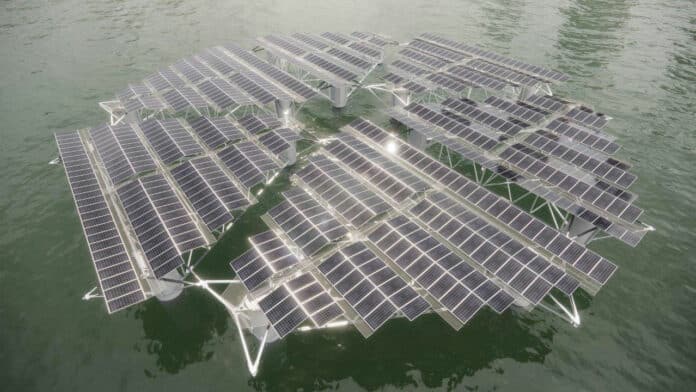Work has started on the world’s largest offshore floating solar power plant that will be showcasing a modular solution. SolarDuck, a company based in the Netherlands, is providing the technology for the plant.
As countries around the world seek to reduce their reliance on fossil fuels, solar and wind-based energy solutions are gaining popularity. While it’s great that these technologies are becoming more affordable, their lower energy conversion rates present a challenge. Both wind and solar energy plants require large plots of land to produce significant amounts of power, which is a problem given the limited availability of land on our planet.
The land is already being used for various purposes, including housing, agriculture, and industry. To address this issue, wind farms have begun to move to offshore platforms, where they can build larger turbines and take advantage of faster winds to generate more clean energy. It’s now time for solar farms to follow suit and move offshore as well.
However, inland water bodies are also limited and often crowded. In areas facing water scarcity, covering canals with solar panels could be a viable solution. However, given that the world’s rivers and lakes occupy only 0.2% of the planet, it may not be a practical solution for every region. Additionally, rivers are already used for transportation, which could complicate the installation of solar panels.
On the other hand, the vast majority of the planet’s surface area – 71%, to be exact – is covered by water. This presents a unique opportunity to create an energy-harvesting system that harnesses the power of abundant sunlight. Netherlands-based SolarDuck is exploring the possibility of installing offshore solar farms in areas that it calls the “Sun Belt.”
SolarDuck has started the 8.4 million euro project to build the world’s largest offshore floating solar plant. The aim is to design, build, and showcase a 5 MW offshore floating solar system using the modular solution of SolarDuck. The system is planned to be electrically integrated, certified, and located within RWE’s OranjeWind (Hollandse Kust West VII) wind farm off the west coast of The Netherlands.
The project is supported with € 6.8 million of the Horizon Europe programme, kicked off in December 2023 to execute research and development on offshore floating solar (OFS) systems and its components.
The nautical SUNRISE consortium is conducting extensive research on various components of the project before construction begins. This way, the team can ensure that the offshore floating project is reliable, survivable, and electrically stable.
Once the research is complete, the team can develop a detailed scale-up plan to address any challenges and facilitate the commercialization of offshore floating solar systems.
Nautical SUNRISE is committed to considering the environmental impact and sustainability of OFS. It’s important to assess the environmental footprint, circularity, and full life cycle sustainability of offshore floating solar systems. This assessment will not only cover the demonstrator project but also include multiple GW-scale commercial projects, ensuring a comprehensive understanding of the technology’s ecological implications.
This project will pave the way for a new era in offshore renewable energy, contributing to a more sustainable future for generations to come.
“This subsidy allows SolarDuck with its partners to push the environmental boundary of the design and at the same time get an in-depth understanding of the ecological and reliability of the design,” SolarDuck’s CTO Don Hoogendoorn says.
